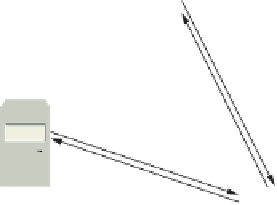Information Technology Reference
In-Depth Information
Intrasite and intersite replication use the same basic processes to replicate Active Directory
data; the primary goal is to balance replication timeliness and efficiency. To that end, the repli-
cation strategy between DCs within a site (intrasite) are optimized for high-speed, low-latency
LAN links. Intersite replication is optimized to take slower WAN links into account.
Intrasite replication can be initiated in one of two ways:
•
Notification
—When a change is made to the Active Directory database, the DC on which
the change was made notifies its replication partners. The partners then request replication
from the notifying DC.
•
Periodic replication
—To account for missed updates, DCs request replication from their
partners periodically. The interval can be configured in the connection object's Properties
dialog box (explained later in the “Connection Objects” section).
Intrasite replication involves two main components: Knowledge Consistency Checker (KCC)
and connection objects.
The KCC, introduced in Chapter 4, is a process that runs on every DC and, for intrasite repli-
cation, builds a replication topology among DCs in a site and establishes replication partners.
As shown in Figure 10-17, each DC in a site has one or more replication partners. For example,
DC 1
DC 2
DC 4
DC 3
DC 6
DC 5
DC 7
Site 1
Figure 10-17
Intrasite replication partners



































































Search WWH ::

Custom Search